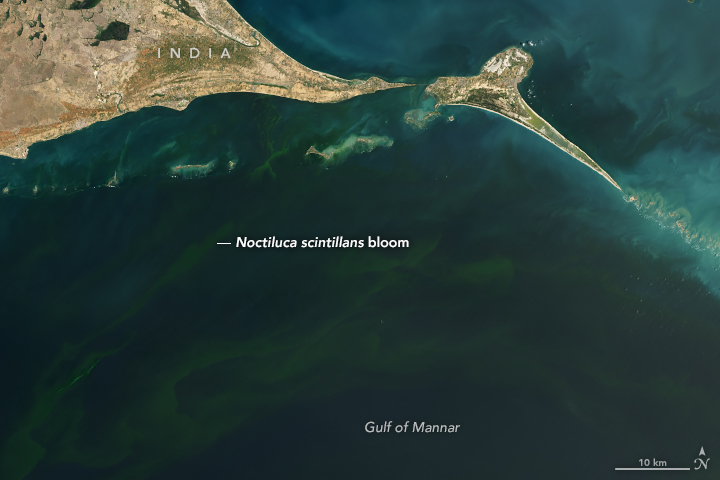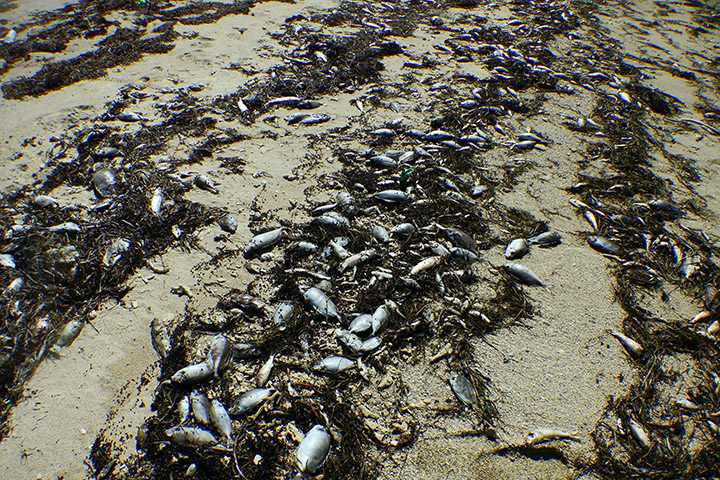
Deadly Blooms in the Gulf of Mannar
Downloads
- indiaalgae_oli2_2022266_lrg.jpg (5035x3357, JPEG)
- greenbloom_pho_gulfofmannar_11oct2022_lrg.jpg (4350x2900, JPEG)
- deadcoral_pho_gulfofmannar_17nov2021_lrg.jpg (4000x2667, JPEG)
- fishkill_pho_gulfofmannar_11oct2022_lrg.jpg (4608x3072, JPEG)
Metadata
- Sensor(s):
- Landsat 9 - OLI-2
- Data Date: September 23, 2022
- Visualization Date: May 5, 2023
For the past four years, water in the Gulf of Mannar has turned bright green in September and October as the population of a single-celled phytoplankton called Noctiluca scintillans soared. These large blooms of the marine dinoflagellates glow a spectacular shade of blue at night, but their presence can have deadly consequences for marine life by soaking up all the oxygen in the water and causing hypoxia and dead zones.
That’s what was happening on September 23, 2022, when the Operational Land Imager-2 (OLI-2) on Landsat 9 captured this image of whorls of N. scintillans discoloring waters in northern Sri Lanka and southern India near the Gulf of Mannar Marine Biosphere Reserve. The shallow water in this area normally teems with coral, reef fish, sea turtles, dolphins, dugong, and other marine life. But during N. scintillans outbreaks, fish carcasses line beaches and dead coral skeletons transform reefs.
“We saw particularly severe coral mortality and fish kill in 2019, but it happened in 2021 and 2022 as well,” explained Diraviya Raj, a researcher at the Suganthi Devadason Marine Research Institute in Tamil Nadu, India, and the lead author of a 2020 study about N. scintillans blooms in the Gulf of Mannar. “The 2020 bloom was short and did not harm corals, but the 2021 and 2022 events each lasted for two months, covered large areas, and caused severe damage.”
The earliest reports of N. scintillans blooms causing fish kills in the Gulf of Mannar date back to 1935, with occasional reports of the phenomenon in subsequent decades. However, the regularity and intensity of the blooms since 2019 seem to be something new. “We suspect that climate change has made the N. scintillans bloom an annual occurrence,” Raj said. “The water temperature level has been more than 30°Celsius (86°Fahrenheit) during the blooms, which is unusually high for the Gulf of Mannar in September-October.”
Living staghorn corals are brightly colored, while the dead corals in the photograph above—taken on November 17, 2021, near Manauli Island—had turned white and were covered with algal debris about a month after the bloom started to affect them. Fast-growing corals species such as Acropora, Montipora, and Pocillopora are the most vulnerable to N. scintillans blooms because they require the most oxygen to thrive.
Lines of dead fish, like those shown below, covered beaches on the islands of the Gulf of Mannar and the mainland near Mandapams and Keelakarai when the photo was taken on October 13, 2021. By analyzing water samples, Raj and colleagues confirmed that oxygen-depleted water triggered by the N. scintillans bloom was the cause of the fish kills and coral deaths.
Another team of researchers from the Central Marine Fisheries Research Institute in Mandapam Camp and the Indian Space Research Organization tracking the blooms found that 38 genera of fish were affected by the 2019 bloom and 43 genera by the 2021 bloom. Among them were parrotfish, rabbitfish, pufferfish, lesser sardines, needlefish, and tarpons, they noted in a study published in March 2023.
The 2021 bloom also killed large numbers of animals being raised in finfish farms, explained Ramesh Kumar, the lead author of the study. However, the team thinks it may soon be possible to warn fish farmers of N. scintillans blooms in advance, using improved satellite mapping abilities and new modeling techniques. That may allow farmers to harvest fish before blooms spread to coastal areas and cause widespread damage.
References
- Gunasekaran, K. et al., (2022) Harmful algal bloom by the dinoflagellate Noctiluca scintillans (Macartney) Kofoid & Swezy severely impacts coral reef fishes in the Gulf of Mannar, Southeast coast of India. Research Square.
- Koushik, S. et al., (2022) Recurrence of dinoflagellates, Noctiluca scintillans bloom and impact on marine faunal communities of mandapam coastal waters in gulf of mannar, southeast coast of India. Indian Journal of Ecology, 49(3), 894-899.
- NASA Earth Observatory (2010, July 13) Phytoplankton. Accessed May 5, 2023.
- NASA Earth Observatory Chlorophyll. Accessed May 5, 2023.
- Rameshkumar, P. et al., (2023) Monitoring of Harmful Algal Bloom (HAB) of Noctiluca scintillans(Macartney) along the Gulf of Mannar, India using in-situ and satellite observations and its impact on wild and maricultured finfishes. Marine Pollution Bulletin, 188, 114611.
- Raj, D.K. et al., (2020) Low oxygen levels caused by Noctiluca scintillans bloom kills corals in Gulf of Mannar, India. Scientific Reports, 10, 22133.
- Ramsar Gulf of Mannar Marine Biosphere Reserve. Accessed May 5, 2023.
- Peter, S.T. et al., (2023) Environmental impact assessment of algal bloom Noctiluca scintillans in the Mandapam group of Islands, Gulf of Mannar Biosphere Reserve, Southeast coast of India. Environment Monitoring and Assessment, 195, 18.
NASA Earth Observatory image by Allison Nussbaum, using Landsat data from the U.S. Geological Survey. Photographs courtesy of the Suganthi Devadason Marine Research Institute. Story by Adam Voiland.
This image record originally appeared on the Earth Observatory. Click here to view the full, original record.


